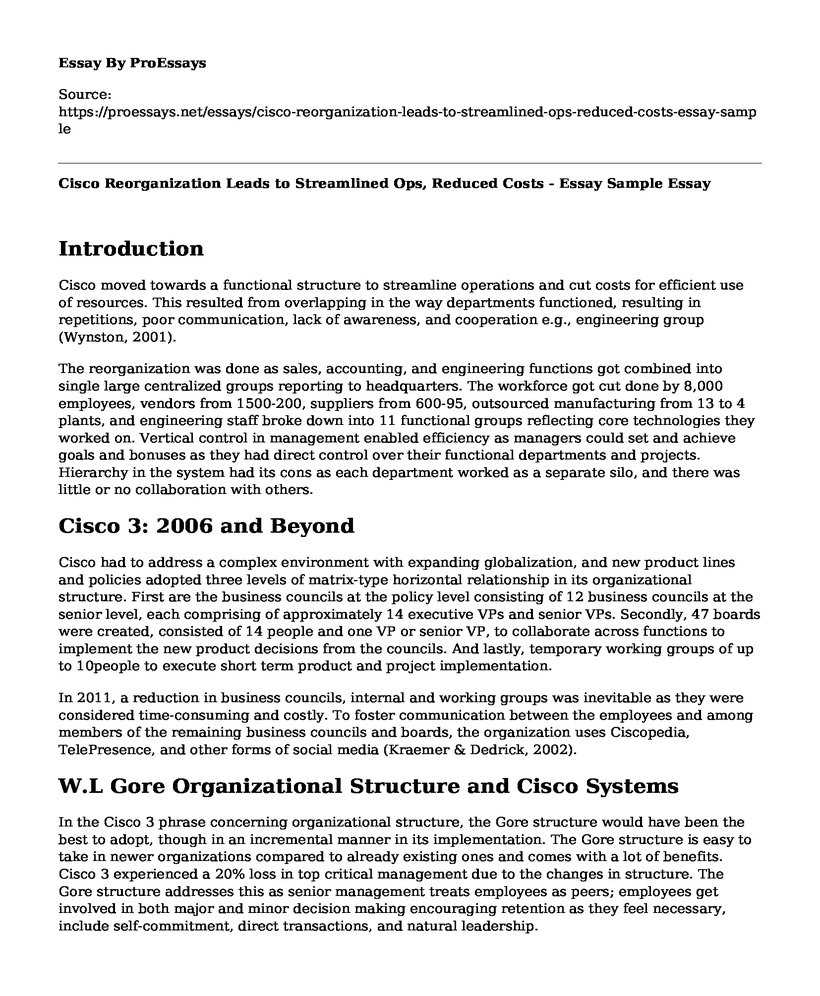Introduction
Cisco moved towards a functional structure to streamline operations and cut costs for efficient use of resources. This resulted from overlapping in the way departments functioned, resulting in repetitions, poor communication, lack of awareness, and cooperation e.g., engineering group (Wynston, 2001).
The reorganization was done as sales, accounting, and engineering functions got combined into single large centralized groups reporting to headquarters. The workforce got cut done by 8,000 employees, vendors from 1500-200, suppliers from 600-95, outsourced manufacturing from 13 to 4 plants, and engineering staff broke down into 11 functional groups reflecting core technologies they worked on. Vertical control in management enabled efficiency as managers could set and achieve goals and bonuses as they had direct control over their functional departments and projects. Hierarchy in the system had its cons as each department worked as a separate silo, and there was little or no collaboration with others.
Cisco 3: 2006 and Beyond
Cisco had to address a complex environment with expanding globalization, and new product lines and policies adopted three levels of matrix-type horizontal relationship in its organizational structure. First are the business councils at the policy level consisting of 12 business councils at the senior level, each comprising of approximately 14 executive VPs and senior VPs. Secondly, 47 boards were created, consisted of 14 people and one VP or senior VP, to collaborate across functions to implement the new product decisions from the councils. And lastly, temporary working groups of up to 10people to execute short term product and project implementation.
In 2011, a reduction in business councils, internal and working groups was inevitable as they were considered time-consuming and costly. To foster communication between the employees and among members of the remaining business councils and boards, the organization uses Ciscopedia, TelePresence, and other forms of social media (Kraemer & Dedrick, 2002).
W.L Gore Organizational Structure and Cisco Systems
In the Cisco 3 phrase concerning organizational structure, the Gore structure would have been the best to adopt, though in an incremental manner in its implementation. The Gore structure is easy to take in newer organizations compared to already existing ones and comes with a lot of benefits. Cisco 3 experienced a 20% loss in top critical management due to the changes in structure. The Gore structure addresses this as senior management treats employees as peers; employees get involved in both major and minor decision making encouraging retention as they feel necessary, include self-commitment, direct transactions, and natural leadership.
Besides the loss in crucial management, Cisco Systems eventually had to reduce the workforce and adapt communication strategies, including the use of social media. The Gore organizational structure is flexible and encourages the flow of ideas and learning as employees are not restricted to one specific area and, therefore, train and acquire different skills, expertise, and knowledge.
References
Kraemer, K. L., & Dedrick, J. (2002). Strategic use of the Internet and e-commerce: Cisco Systems. The Journal of Strategic Information Systems, 11(1), 5-29.
Wynston, M. (2001). Cisco Enterprise Management Solutions: Volume I. Cisco Press.
Cite this page
Cisco Reorganization Leads to Streamlined Ops, Reduced Costs - Essay Sample. (2023, May 06). Retrieved from https://proessays.net/essays/cisco-reorganization-leads-to-streamlined-ops-reduced-costs-essay-sample
If you are the original author of this essay and no longer wish to have it published on the ProEssays website, please click below to request its removal:
- Types of Project Delays
- Review of Dragon's Breath LLC Qualifications Paper Example
- Research Paper on Conscientiousness and Agreeableness Personality Traits on Nursing Leadership
- Essay Sample on Team Building: Appreciate, Understand, Develop & Maximize Team Performance
- Essay Sample on Risk Management & Mitigation Strategies: Accepting, Transferring & Avoiding
- Essay on Emoji in Corporate Documents: Misunderstandings and Consequences
- Essay Example on Elderly Fire Risk Reduction: Identifying & Prioritizing Risks







